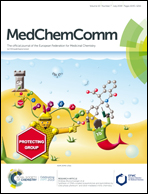Druggability assessment of mammalian Per–Arnt–Sim [PAS] domains using computational approaches†
Abstract
Per–Arnt–Sim (PAS) domains are key regions that occur in different regulatory proteins from all kingdoms of life. PAS domains show a remarkably conserved structural scaffold, despite a highly variable primary sequence. In this study we have attempted to address some of the gaps in knowledge regarding the druggability of PAS-A domains, differences in structure and dynamics within the PAS domain family and how this affects the druggability potential, as well as give insight into the druggability of steroid receptor coactivators and putative binding modes of the NCOA1. Investigations were performed through a range of computational methods including molecular docking studies, atomistic molecular dynamics simulations, and hotspot mapping. Atomistic molecular dynamics simulations show that the function of the AhR PAS-B domain is regulated by the dynamics of the highly conserved tyrosine Y322 residue, which acts as a “gatekeeper” controlling the access to the binding cavity and finely tuning the binding affinity. Furthermore, the transition between the partially unfolded and helical conformation of the loop1 segment within PAS-B domains was shown to be essential for the generation of “druggable” sites, especially for the NCOA1 PAS-B domain. Finally, our simulations indicated the undruggability of PAS-A domains, caused by the inherent characteristics of their putative binding sites. In conclusion, this work emphasises the role of intrinsic dynamics in tuning the druggability of PAS-B domains and shows that PAS-B domains of steroid receptor coactivators, such as NCOA1, can be targeted by small molecule ligands, which highlights the potential of developing new therapeutics designed to target these coactivators using structure-based approaches.
![Graphical abstract: Druggability assessment of mammalian Per–Arnt–Sim [PAS] domains using computational approaches](/en/Image/Get?imageInfo.ImageType=GA&imageInfo.ImageIdentifier.ManuscriptID=C9MD00148D&imageInfo.ImageIdentifier.Year=2019)


 Please wait while we load your content...
Please wait while we load your content...